 Welcome to Part Five of our WordPress Website Traffic Blueprint article series, where we show you how to turn a website into an automated traffic machine using the WordPress CMS.
Welcome to Part Five of our WordPress Website Traffic Blueprint article series, where we show you how to turn a website into an automated traffic machine using the WordPress CMS.
So far, here is what we have covered in this article series:
In Part One of this article series, we provided an overview of the traffic automation process, and explained why using an expertly configured WordPress site is the key to generating automated traffic …
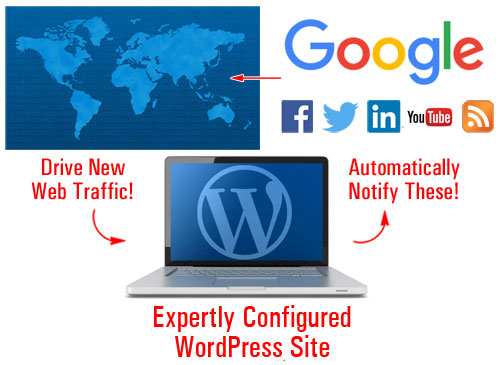
(With an expertly configured WordPress blog, all you have to do to attract more traffic is add great content consistently!)
In Part 2, we look at critical setup decisions. We help you understand the best way to start if you don’t have a website yet, how to set things up if you already have a site, and what to do if your existing site has been built using WordPress.
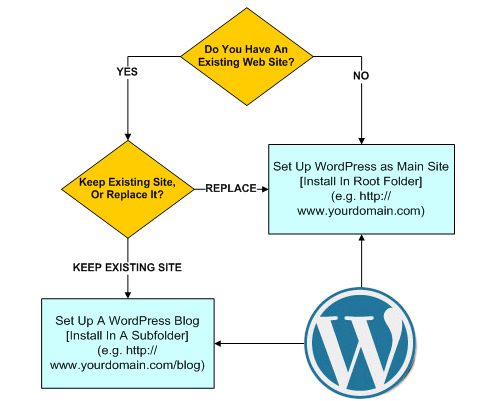
(In Part two we show you where to set up WordPress on your domain)
In Part Three, we focus on the configuration phase. We configured all the settings (hosting, internal and external) that can affect your site’s traffic-getting ability …
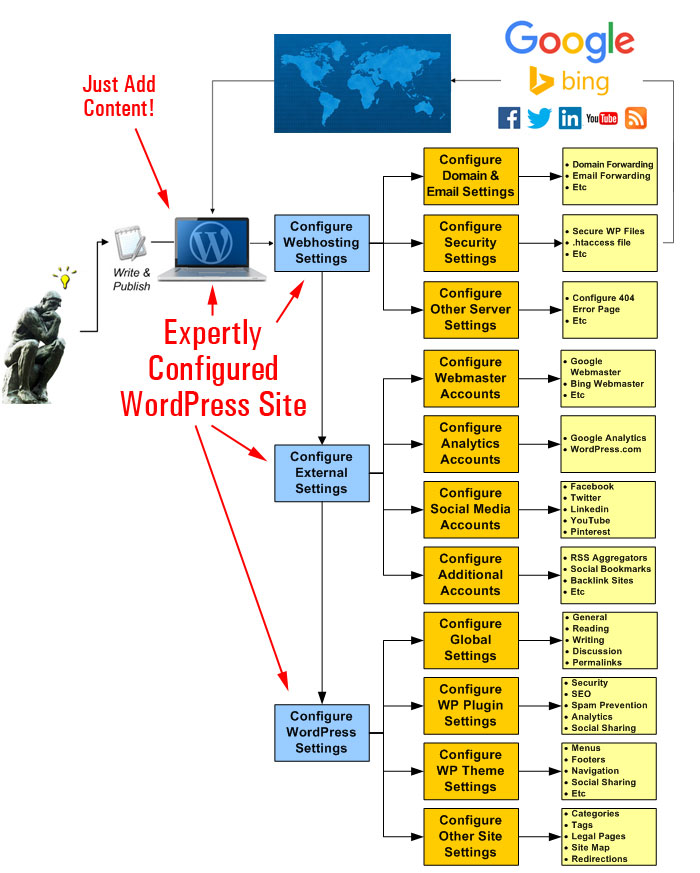
(In Part 3 you learn how to configure all the settings that can affect your website’s traffic-getting ability)
In Part 4, we looked at ways to automate your traffic with WordPress plugins.
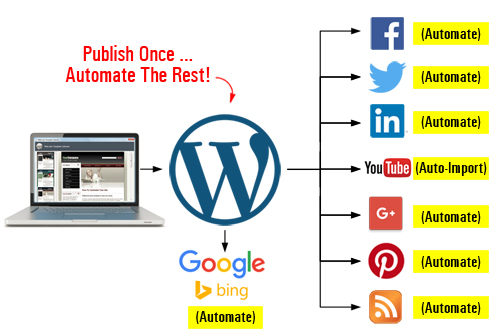
(Publish content one-time, automate the rest!)
In this section of the WordPress web traffic automation blueprint series, we discuss ways to optimize traffic to your website using various tools and methods.
WordPress Traffic System – Systems
In addition to having an expertly configured WordPress website or blog, generating consistent traffic of high quality is achieved by having a clear business vision, sound digital planning, and good systems and process in place.

(Automated traffic is the result of having a clear business vision, sound planning, and excellent systems)
Let’s review briefly the systems that will help you grow and manage this traffic.
These include:
- Marketing Systems – How you create new traffic for your website.
- Technical Systems – How you keep your online presence operating efficiently for receiving traffic.
- Business Systems – How you manage and respond to traffic.
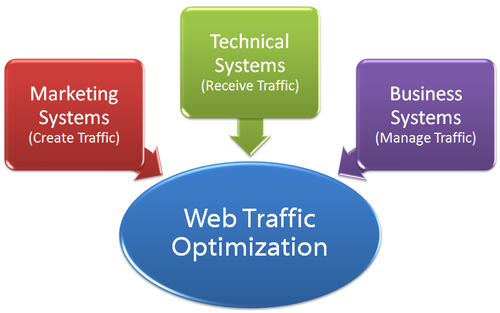
(Use systems to grow, automate, optimize, and manage your web traffic)
Let’s review the importance of the above systems briefly:
Marketing Systems
Your marketing systems consist of the processes and methods used to drive new traffic to your business. Your online marketing systems can be tested by asking questions such as:
- What channels do you plan to use to generate traffic (e.g. blogging, facebook advertising, video marketing, etc)?
- What resources and portion of your budget will you apply to these channels?
- How will you create and optimize your content and run your marketing campaigns?
- How will you track conversions and measure the results of your campaigns?
During the setup and configuration phase, you would have installed an analytics program (e.g. Google Analytics). If you’re just starting out, you may want to consider investing in some paid advertising to help generate some initial data, such as the keyword phrases people are searching online to find your website, which you can use to create content better targeted to your audience’s needs.
Technical Systems
Your technical systems and processes ensure that your online presence remains optimized for receiving traffic. There’s no point driving traffic to your site if your site is down or your web pages are taking too long to load.
Your systems need to handle technical areas like webhosting, website maintenance and support, installing, configuring, and updating software (e.g. plugins), customization, integration, troubleshooting, etc.
Your technical systems can be tested by asking questions such as:
- Who is looking after my server?
- Who looks after my website and keeps my site, plugins, themes, etc. maintained and up-to-date?
- Who will fix errors, troubleshoot problems, provide technical support and advice, etc. should things go wrong?
Many potential issues can be minimized if your website planning and setup and configuration phases have been done correctly. Like all technology, however, you should expect new problems to arise. Your technical systems need to be able to handle these.
Business Systems
You need good business systems and processes in place to help you manage and respond to traffic. This includes:
- Communication systems
- Resources management – human, financial
- Handling sales enquiries
- Order fulfillment
- Customer training/service
- etc.
If you intend to outsource your digital marketing and technical maintenance, then make sure you have excellent systems in place to manage all outsourcing processes.
WordPress Traffic Automation Blueprint – Traffic Optimization
With clear business objectives and great systems in place, all you need to focus your efforts on is growing, optimizing and automating a “traffic loop”.
Let’s walk through an example of implementing, optimizing, and automating a traffic loop. Take a look at the flowchart below …
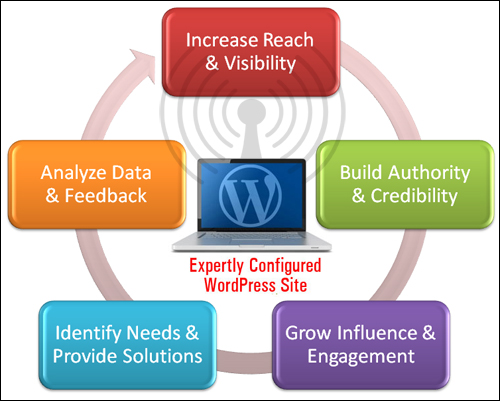
(Implementing, automating and optimizing a traffic loop)
Increase Reach And Visibility Online
The first step of the process is to increase visibility for your website or blog.
Useful Tips And Ideas
- Your expertly configured WordPress site will allow you to instantly share your content on traffic-getting sources like Facebook, Twitter, GooglePlus, etc. The easiest way to increase your reach and visibility online, therefore, is to simply publish more content through your expertly configured WordPress site.
- As mentioned earlier, investing in some paid advertising (e.g. Facebook ads) can help generate some initial data, which you can use to create web content better targeted to your audience.
- Repurpose your content to leverage the power and reach of different media formats.
- Continue learning about ways to drive web visitors using methods like Pinterest, PPC advertising, forum signatures, etc.
Tools And Strategies
We’ve covered many useful plugins, tools, and methods in previous sections of this article series.
Also, see other posts on this site to learn more about plugins that let you easily add the following to your site:
- Share your comments and posts online with others,
- Run contests, offer discounts or downloads for shares/likes,
- Accept user generated content, feeds, etc.
- Publish and distribute content online in other media formats (e.g. videos, PDF guides, slides, etc.)
Build Authority And Credibility
Getting more of your content published is great, but for this activity to be really effective, your content also needs to build authority and credibility with users.
Publishing authoritative content not only helps to establish your credibility, it also improves your chances of getting more people to link to it and share it around and hence more traffic.
Traffic Tips
- Create and publish content that will add value to your audience and showcase your expertise. This includes content that informs and educates readers, training content, case studies, adding testimonials, etc.
- Consider publishing expert reports that you can sell or distribute online.
Tools, Plugins, & Strategies
If you need help coming up with unlimited great ideas for content that you can post on your website, then subscribe to our email training series on growing your business with content marketing here:
Also, if you haven’t already, learn more about plugins that allow you to easily add the following to your site:
- Legal Pages
- Testimonials
- Customer Support (e.g. Helpdesk, Live Chat, etc.)
- Ratings
- User Reviews
- Badges/Certificates Of Trust
Grow Influence And Engagement
As your business grows, you may want to consider developing “traffic on demand.” You can do this by growing a list or starting an online community.
With “Traffic On Tap,” all of your traffic comes from an audience of customers or subscribers – people who already know you and trust you. Your influence and credibility can be used to generate new traffic with every post you publish, forum post you add, or email broadcast you send out.
Useful Tips
- Encourage commenting and discussions on your site.
- Add an autoresponder newsletter and encourage people to subscribe.
- Add a free, paid, or ‘freemium’ membership site.
- Start or join an online group on Facebook.
Tools, Plugins, & Methods
Many solutions and WordPress plugins are available that can help grow your influence and improve user engagement. For example:
- Autoresponders (e.g. Aweber, MailChimp, etc.)
- Contact Forms, Live Chat
- Forums & Social Communities (e.g. bbPress, BuddyPress)
- Polls & Surveys
- Webinars (e.g. Webinar JEO)
- Comment sharing
- Add media, video galleries, etc.
Identify Needs & Provide Solutions To These
By taking advantage of incoming traffic to find out what your visitors need, you can have an endless funnel of ideas for new services, products, and solutions, all of which can provide you with new opportunities for generating additional web traffic.
Tips
- Create an e-learning program.
- Publish a special report that can be sold or distributed online.
- Add e-commerce to your business.
Tools & Strategies
If you plan to provide services and products online (as opposed to just providing information), then some of the more useful WordPress plugins you may want to add to your website include:
- Membership Sites (e.g. Wishlist Member, S2 Member, etc.)
- e-Learning Courses (e.g. Courseware)
- Event Registrations (e.g. EventEspresso)
Analyze Data & Feedback
The final step of the process is to collect and analyze data. By interpreting data gathered from existing traffic, you can discover new opportunities to create content that can help you generate additional traffic.
Hopefully, by now you already have installed an analytics tool like Google Analytics on your site. Make sure you also learn how to interpret the data.
WordPress Traffic System – Summary
Once you implement the above strategies, all you have to do is repeat the same process, fine-tuning and refining your methods as you go to grow your traffic and improve your results.
In summary:
- Start with an expertly configured WordPress site backed by solid marketing, technical and business systems,
- Implement a content marketing strategy (consider also investing in some paid advertising to drive traffic and generate useful data) to increase your reach and visibility online,
- Add plugins, list-building strategies, and other methods as necessary to help build authority, trust, and credibility, and also to improve engagement with users,
- Promote any new solutions, products or services using your existing channels and strategies to generate additional streams of traffic,
- Analyse your data and your results, automate your processes wherever possible, and begin the cycle again.
Hopefully, this information has given you a blueprint that will help you drive more visitors automatically to your website and build a more successful business online.

***
"Your training is the best in the world! It is simple, yet detailed, direct, understandable, memorable, and complete." Andrea Adams, FinancialJourney.org
***